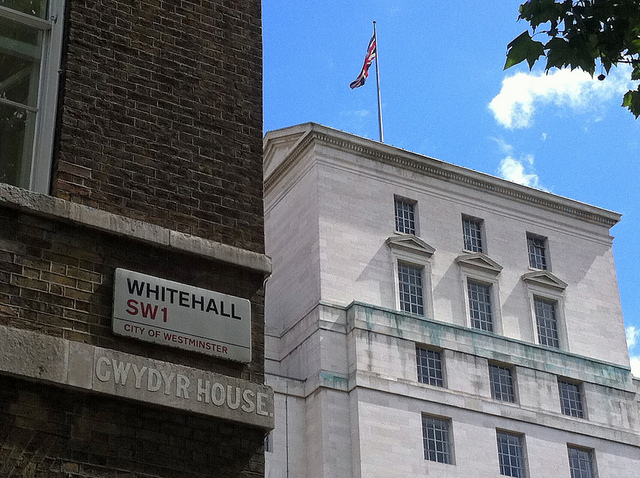Voters in countries with high-visibility welfare states are more ideologically consistent in voting
Voters in highly visible welfare states vote in ways consistent with their preferences on redistribution and state spending. Making spending more visible can heighten the salience of welfare and galvanise its support, but it can also be the kindling of a tax revolt, argues Jane Gingrich.

Credit: Steph Gray, CC BY ND 2.0
Do voters understand what government actually does? And does that matter for how they make choices in the ballot booth? When political elites debate issues such as the proper level of public spending or taxation, these debates often assume that voters understand what the government already does. Research coming out of the United States, however, suggests that this assumption is often deeply flawed. In her analysis of American social programs, political scientist Suzanne Mettler shows that many people who are recipients of public programs do not know that they are receiving such a benefit. Moreover, knowledge of benefit receipt varies greatly across programs. While almost three quarters of people receiving direct public benefits – like food stamps or public pensions – are aware that they are receiving benefits, Mettler finds that only around a third of people receiving lower visibility tax breaks understand they are receiving a public benefit.
This research raises two questions of great importance for our understanding of public support for the welfare state and people’s vote choices. Are there systematic features of the existing policy environment that help citizens understand what the state does and for whom? Does this information matter for citizens’ political choices?
Across wealthy democracies, social programs vary substantially in what kinds of information they provide to both recipients and citizens more generally. Some benefits are provided directly, and are “what you see is what you get”. For instance, most public programs in the UK provide citizens with direct income support, usually through a direct deposit from a government program such as National Insurance. This benefit is usually not taxed, meaning that both who provides the benefit and its real value are quite apparent to voters. Other benefits are less clear on both counts. Some programs, such as the Child Tax Benefit and the Working Tax Credit or Council Tax Benefits, work through the tax system, either offering citizens a transfer via the tax authorities or reducing their tax liability. This makes it less clear to citizens both that they are receiving a benefit and in terms of its value. By contrast, in other countries, generous benefits are often heavily taxed, meaning that the benefit may seem more generous than its actual value when we take the tax system into account.
Across countries, there are striking differences in the use of tax-based benefits. In 2009, the United States spent about 18.6% of GDP on direct social benefits; yet once the tax system was accounted for, this amount actually rose to 20.7% of GDP because of the use of tax benefits. By contrast, many Nordic countries, such as Finland, heavily tax back direct benefits. In 2009, Finland spent 29.4% of GDP on social welfare, but after taxes, this amount fell to 23.9% of GDP. Put differently, in some countries, additional resources are provided to citizens through the tax system, while in others, taxes reduce the value of these benefits. The United Kingdom has a relatively neutral tax system in this regard, with pre-tax expenditure amounting to 24.1% of GDP and post-tax expenditure amounting to 23.7% of GDP.
Do these differences actually matter? Suzanne Mettler’s research in the United States suggests that directly provided benefits tend to be more visible and easier for voters to understand than tax-based benefits. These findings suggest that welfare states that rely on generous but taxable benefits may be ‘overly’ visible, creating highly salient welfare policy. By contrast, countries that rely on many tax based benefits may be low-visibility, reducing the salience and clarity of the state to voters.
My own research has found that such differences do matter. Voters in higher visibility states, defined here as that use the tax system to make spending more visible (i.e. by providing generous benefits and taxing them back) find it easier to estimate benefit levels. These voters also attach greater importance to welfare issues in electoral surveys.
The implications of these differences are subtle but important. Voters in higher visibility contexts are not necessarily more pro-welfare or in favour of higher taxes and spending. However, they do tend to weigh these issues more heavily in their political choices. Put differently, they tend to pick parties closer to them on welfare issues, rather than other issues. Of course, the relative importance of the welfare state to voters varies across time and place, depending on how political parties discuss these issues and the spectrum of choices that voters have.vi Nonetheless, in general, voters in countries with high-visibility welfare states are more ideologically consistent in voting, and in particular, vote in ways consistent with their preferences on redistribution and state spending.
The implications of these findings for the welfare state in the UK are mixed. On the one hand, changes that make spending more visible to either recipients or taxpayers – such as the move to the universal credit for income support benefits – may actually heighten the salience of the welfare state. If voters can better understand what the state is doing, and for whom, they may begin to attach more weight to social policy in their political decision-making. Given how widespread benefit receipt is these movements could galvanise support for the state.
On the other hand, my work shows some of the most ideologically consistent voters in wealthy democracies are supporters of lower taxes in Scandinavia, a group that consistently votes for non-socialist parties. More visible spending can also clarify the revenue side, potentially creating support for anti-tax and spending groups. Visible benefits then might create the kindling for a tax revolt.
—
Note: This piece originally appeared on Policy Network’s website. It represents the views of the author and not those of Democratic Audit or the LSE. Please read our comments policy before posting.
—
 Jane Gingrich is Tutorial Fellow in Philosophy, Politics and Economics at Oxford University
Jane Gingrich is Tutorial Fellow in Philosophy, Politics and Economics at Oxford University





 Democratic Audit's core funding is provided by the Joseph Rowntree Charitable Trust. Additional funding is provided by the London School of Economics.
Democratic Audit's core funding is provided by the Joseph Rowntree Charitable Trust. Additional funding is provided by the London School of Economics.
Voters in countries with high-visibility welfare states are more ideologically consistent in voting https://t.co/85WeHoV6fl #GigatownGis UFB
“@PJDunleavy: Voters in countries w. high-visibility welfare states are more ideologically consistent in voting https://t.co/mt7JrwtaXg” #fb
Voters in countries w/ high-visibility welfare states more ideologically consistent in voting https://t.co/1NoFG4i92s https://t.co/Di9yxsifhK
Voters in countries with high-visibility welfare states are more ideologically consistent in voting https://t.co/VwtmgrbWxP
Voters in countries with high-visibility welfare states are more ideologically consistent in voting https://t.co/X8Rt1rMbK4